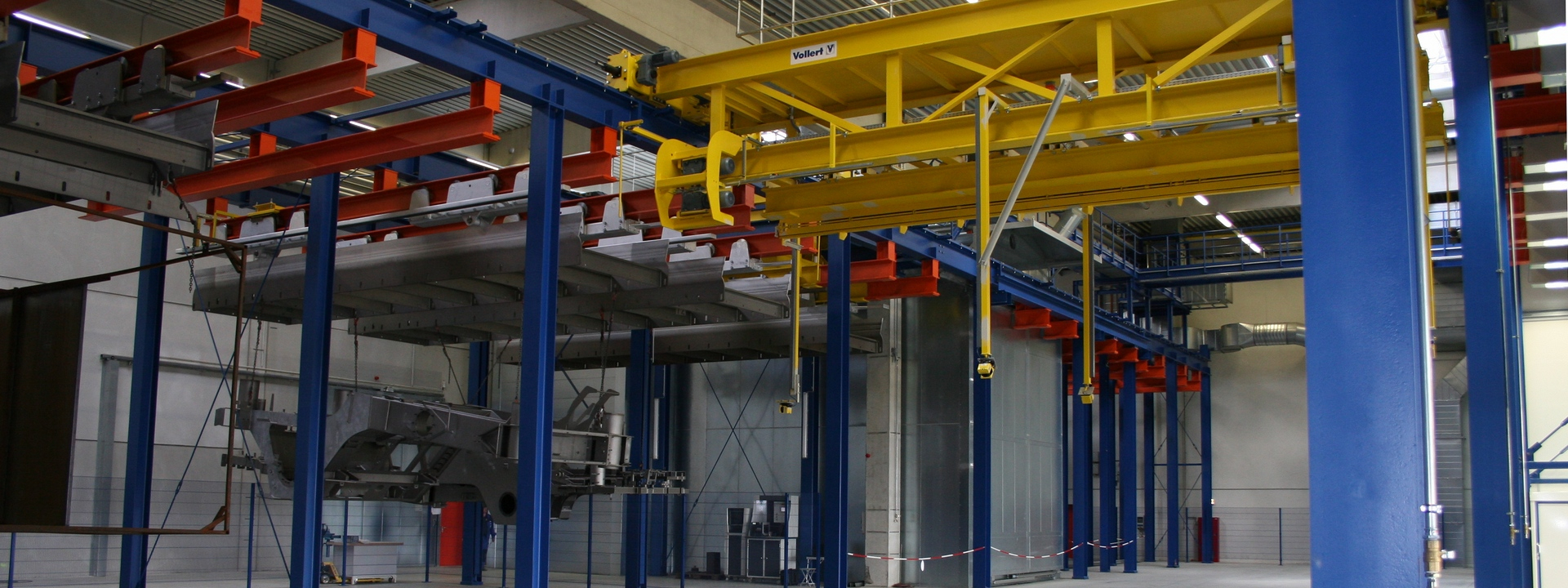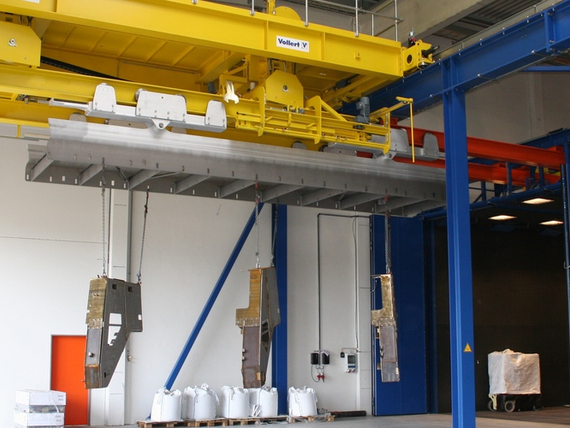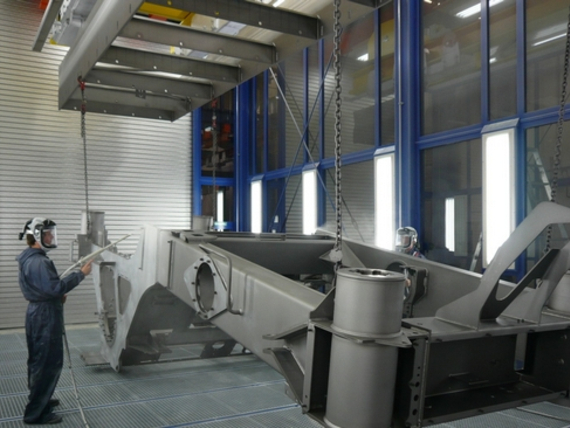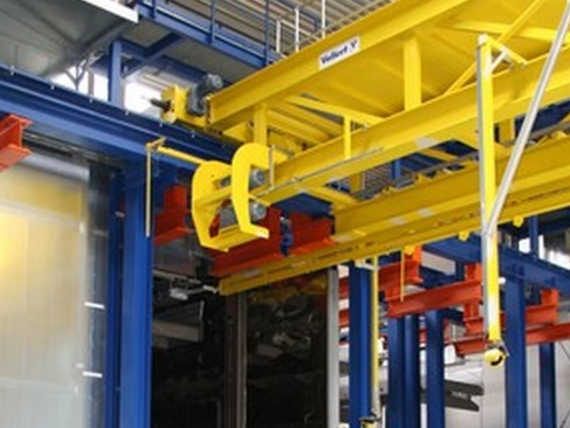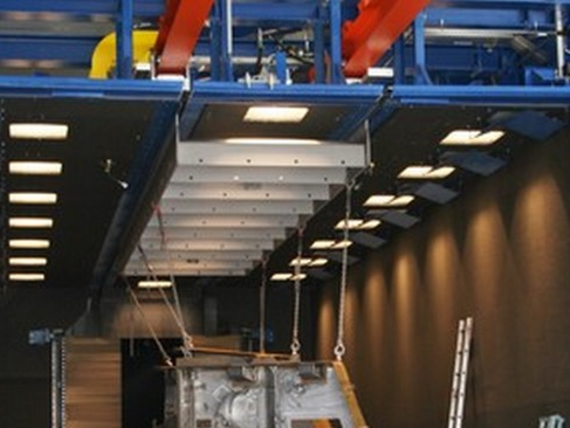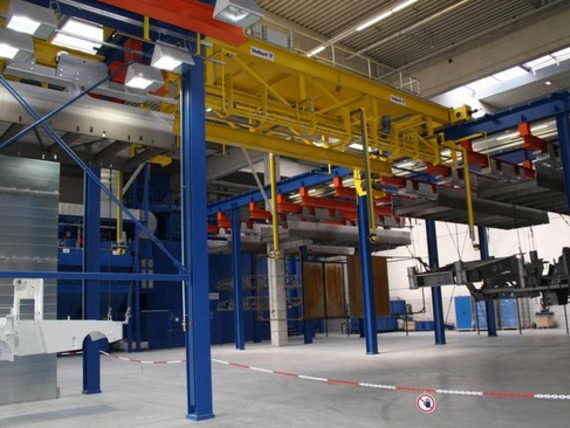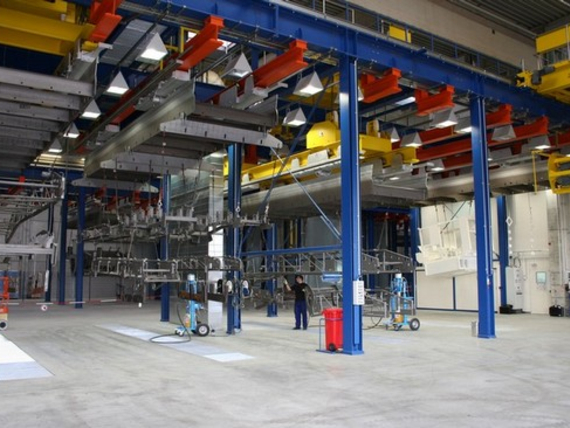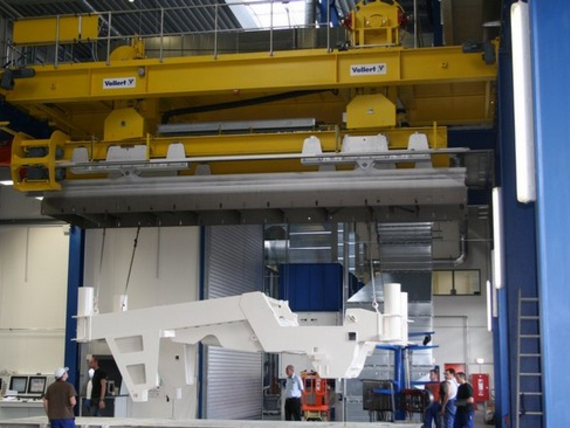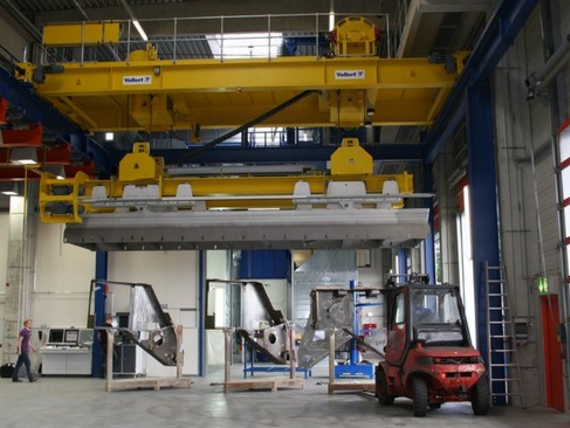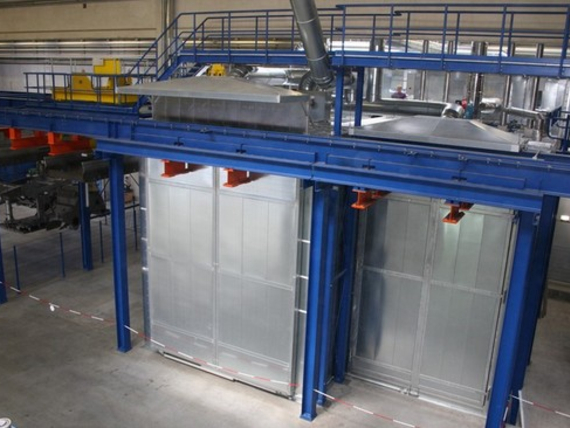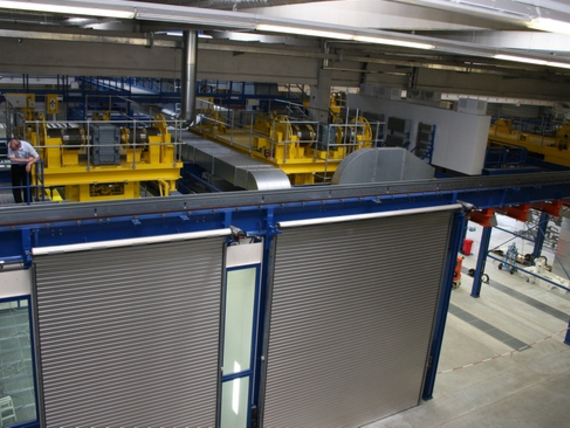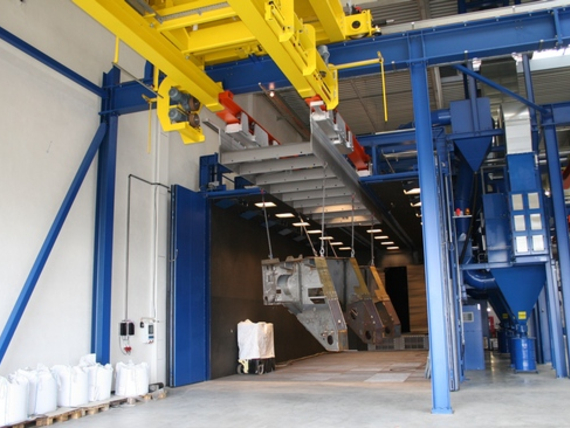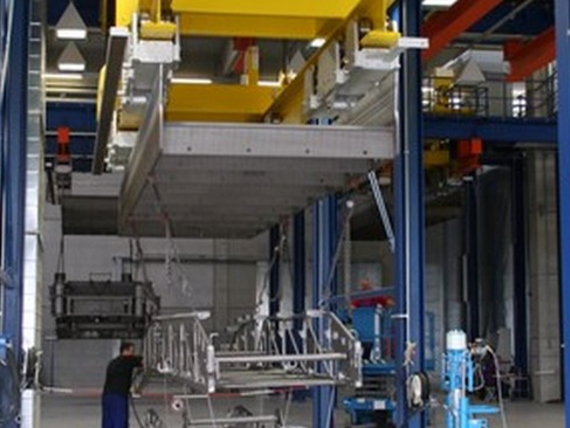With components of up to 30 tons, ovens reaching temperatures of 230 °C and a 70 cm gap bridging - the world's first double-track suspension system for painting and powder coating by Wirtgen GmbH really is the leader in its field. But being the industry leader and handling large components are part of the daily business for the manufacturer of cold milling, cold and hot recyclers and other technologies for road construction. In just under 50 years, the Windhagen-based company has developed from a one-man business to a global market leader with 4,500 employees, four main plants in Germany and additional production facilities in Brazil, the USA and China. Apart from Wirtgen, the mechanical engineering companies Joseph Vögele, Hamm and Kleemann also belong to the Wirtgen Group - all well-known manufacturers of high-quality mobile machinery and road construction systems and the processing and extraction of mineral raw materials.
Floor-free coating despite very heavy components
The new plant in the Wirtgen main plant on the A3 between Cologne and Frankfurt will be used predominantly for coating special mobile machines for the surface mining, cold recycling and slipform paver product divisions. The individual components of these large components are transported during the coating while freely suspended. In contrast to ground-based transport systems, this system simplifies the processing and painting and accelerates material flow. "Floor-less transport systems are an advantage in coating systems, but most systems are not designed for loads over 6 to 8 tons. Nobody has built anything like this before," explains Dieter Schnell, Project Manager at Vollert Anlagenbau. "We have therefore developed a new system for ceiling-mounted systems up to 50 tons, which simultaneously transport units without individual drives and thus without electrical power to the coating booths and ovens - the optimal explosion protection."
Friction-wheel drive from the building materials industry
The engineers at Vollert did not have to look far. In addition to heavy-duty systems for the metal and aluminum industry, the intralogistics specialist also develops conveyor systems for the building materials industry, including pre-cast concrete plants. This is the area from which the heavy-duty suspension track principle stems. The unique feature about this system is the friction wheel drive: Instead of individual electrical drives on the transport units stationary friction wheels at regular intervals drive the components forward. These are suspended in transport trusses, depending on their size, individually or in groups. Automatic cranes, so-called distribution manipulators, pick up the trusses at central points and drive them to the individual workstations. The friction wheels and rack-and-pinion drive are also responsible for picking up and pushing the manipulators. As a result, no power supply is required in the painting and drying booths. This saves costs: "Explosion-proof protected drives are more expensive and prone to failure," says Dieter Schnell, "because they are exposed to contamination from paint and powder mist in the booths, which requires constant maintenance. In contrast, our plant is almost maintenance free. "Liebherr, the excavator and crane manufacturer, has been operating two single-girder suspension platforms from Vollert for components of up to 20 and 50 tonnes for several months. The concept has already proven itself here. The new double-track solution at Wirtgen is necessary owing to the large dimensions of individual components and partially one-sided high loads.
High flexibility: Powder and wet painting possible
Wirtgen's coating line is designed for painting and powder coating. Two powder and one wet painting booth are available for this purpose. The components are pretreated in a blasting booth after which they are cleaned, taped or troweled on preparation sites. At the start of the plant, a loading and unloading manipulator of 9 m high, 10.5 m wide, equipped with a hoist grabs the available components suspended in the transport units. The manipulator is designed as a mobile, ceiling-mounted bridge and can reach the workstations that are arranged parallel to one another over a length of 30 m. Thanks to the workstations' parallel arrangement, it is possible to criss-cross the components and thereby grab, pull forward, remove or return them.
The blasting booth is equipped with a metal Wheelradator blasting wheel. An individually tunable driving speed ensures optimal and consistent results. In the process, only the carrier unit with the components is located inside the booth - the suspended track and friction wheel technology are located outside and protected from contamination by the blasting medium by a seal. After blasting, the return trip to the distribution manipulator and automatic onward transport to the preparation sites follows. Two of these spots have walk-in hoists, allowing for the lowering of smaller components and more ergonomic work. As a result, additional work platforms are not required to maintain the minimum driving height of 50 cm during transport, required for occupational safety reasons. Appropriate hoists are also installed in the painting and powder-coating booths.
Following preparation, the components are driven to the back of the workstations. A second distribution manipulator connects the painting and powder-coating booths via a distance of around 45 m as central distribution station to the ovens and cooling stations.
At 230 °C, the steel construction expands to 40 mm
One of the biggest challenges for the engineers at Vollert was not just the high loads Wirtgen required - normally Wirtgent transports components of up to 20 tons, special components of up to 30 tons are also possible - but rather the high temperatures and the connection of the two ovens for the powder coating to the intralogistics system. When using wet paint, the components are merely dried, but the powder coats require baking. The ovens therefore operate at temperatures between 70 and 230 °C. The painting and drying technology comes from SLF in Greven-Reckenfeld. The problem: At 230 °C, the inner steel construction stretches and deforms by up to 40 mm. Still, the transport of the components must always run smoothly. The second challenge was to minimize energy losses of the ovens caused by thermal bridges and gates. Both are only possible if the steel construction of the furnaces and the transport steel construction are structurally separated and isolated by a gap. However, this gap must be bridged by the intralogistics system - with a load of 30 tons. Only then, large and heavy insulation gates of 20 cm thick can completely close the furnace. "The requirements were not easy," says Waldemar Bukal, Project Manager at Wirtgen GmbH, "but with Vollert's solution, gap-bridging was possible and all our requirements have been met in the best possible way." In fact, the Vollert's plant for Wirtgen instead of sliding gates, swing gates could be used even in front of furnaces, which don't hinder access to the neighboring workstations. The distribution manipulator and friction wheels can also handle the hot transport units directly after drying and transport them inn the cooling stations. At the end, the return transport to the loading and unloading manipulator and the return to production takes place.
Energy-saving and economical solution
"We are very satisfied with the overall system and the execution by Vollert. With the new plant we can work faster and more flexible; and it is a cost-effective and energy-saving solution. We have therefore found a sustainable coating solution for our main plant in Windhagen," Waldemar Bukal emphasizes. Besides the construction, Vollert also took over the project management and project coordination of the project partners involved in powder coating, blasting and application supply. The specialists from Weinsberg will also carry out the CE certification after commissioning. Wirtgen is impressed by the new concept: The engineers from Vollert also installed an almost identical system for the sister company Kleemann in Göppingen, using synergies in the development process. For example, the transport traverses at Wirtgen and Kleemann are identical. From the end of the year, Kleemann will then be coating components of crushing and screening equipment. The product range includes stationary and crawler-mounted machines, with which up to 1,000 tons of material can be processed per hour.

